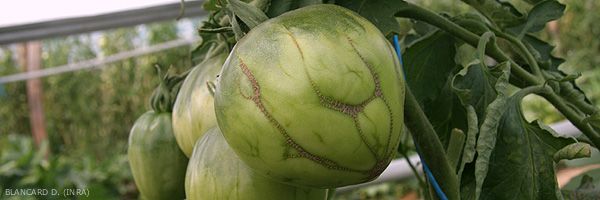
"Zipper" fruits
( zippering )*
( zippering )*
- Symptoms on fruits
Fine brown and necrotic scars, suberized, more or less encircling the fruits along their length and / or their width (figures 1 and 2). They can connect the peduncular scar with the stylar scar or sometimes form a longitudinal scar perpendicularly, giving them the appearance of a zipper which is the origin of the name of this condition.
They are also the cause of localized bursts on certain fruits. Indeed, the suberized tissues having locally lost their elasticity are not able to compensate for the spurts of fruit growth. The seeds and placental tissue are then visible.
- Origin of damage
Non-parasitic disease
Disruption of flowering and then fruit set due to too low temperatures. Thus, the anthers would remain attached to the ovarian walls during the formation of the new fruits, which would lead to the appearance of these fine corky scars.
Varieties do not all have the same sensitivity to this physiological condition.
- How to cure it
Once the damage has appeared, it is often too late to intervene. This anomaly is very dependent on the variety you are growing. We can still suggest that you ensure maximum comfort to the plants during the flowering period of the first bouquets.
The climate
- Avoid keeping night temperature setpoints too low.
- Ensure optimal humidity in the shelters, especially not too low or too high.
The plant and its behavior
- Grow less sensitive varieties.
- Remove early deformed fruits in order to regulate the bouquets.
* A symptom resembling zippering and called " spider track " is reported in the United States in particular. Of unknown cause, this problem is characterized by a greater number of black necrotic scars, mainly localized in the stalk area of the fruits. These are in no case in connection with the peduncular scar, but arranged radially with respect to the latter. Dark green to yellow streaks, depending on the stage of maturity of the fruit, "radiate" from the stalk scar. Tomato varieties do not all have the same sensitivity to this condition, cultivars with large fruits would be more susceptible.





